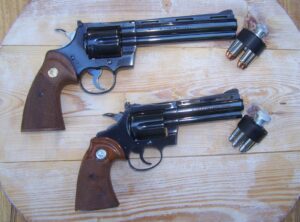
By Michael E. Haskew.
Published by Amber Books Ltd.
74-77 White Lion Street, Dept. TGM
London N1 9PF, UK.
Price: $34.95. Available through most bookstores.
Listed as one of the Collector’s Guides series, this 224-page hardbound volume provides usable information on most Colt-produced products.
Following a brief Introduction, this tome is divided into four sections, from Percussion Revolvers 1830-1905 to Machine /guns, Rifles and Assault Rifles. There is also a short Glossary and an Index.
Colt shotguns are covered in the last section with the other Colt long arms, beginning with the 1878 side/side hammer gun. During the dozen years it was in production over 22,000 side-by-sides were turned out in 1-0 and 12-gauge versions. In the 1960s, Colt got back in the game again, but not the total production end by importing various models and/or assemblies from Europe and branding them with the Colt name.

One of the last Colt shotgun projects was the unique, short-lived eight-barrel 20-gauge Defender of the late ’60s. Four versions were available, and of the models this reviewer was able to handle, it may have had some use in the law enforcement field, but apparently not. It was dropped by around 1971.
Most of this fourth section is devoted to the Armalite-developed AR-10/AR-15 line which Colt produces in many variations for the military as the M16, and its variants. The bolt action Colt sporting rifle as produced by Sauer is covered, but not the Colt-Sauer produced Drilling.
If you mention the name Colt to any firearms-knowledgeable person, he or she will usually picture in their minds, one of three firearms—the 1873 Single Action Army, the M1911 semi-auto, or the M16 [AR-15]. However, over the years the Colt firm has probably produced more revolver models than any other firm and these are covered in the first section, which takes up more than half of this interesting treatise.
This volume is lavishly illustrated with color photographs of each model discussed, in addition to a few other photos (even the gray-colored end papers show a line of military men advancing shooting their pistols). In the margin of the pages with photos is a specs table for that specific arm. In the table is such information as Date (of introduction), Caliber, Weight, Overall Length, Barrel Length, Feed/Magazine, and Effective Range. Weights, lengths, etc., are generally listed in both English and metric units.
There are a few errors, typos, etc. The most glaring error is the revolver Second Generation Peacemaker. The revolver shown on a flap holster is not an actual single action M1873 revolver, but a double-action pot-metal, or plastic cap pistol similar to one this reviewer had when he was about eight years old. (Note the trigger placement, trigger guard shape, front sight shape, hammer face, non-movable cylinder molded integral with the frame, short ejector rod housing, etc.) Very interesting!
This Colt book is worth having on any shooter and/or collectors reference shelf, as it does contain some valuable information and it does have some good information on most Colt firearms. Decades gone, modernized versions of the lever action Colt-Burgess rifle and pump action Lightning carbine might just find ready markets.—Larry Sterett



